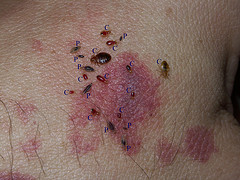
flic.kr/8MS7hU
Having a good night’s sleep could truly be impossible if your bed is infested with bed bugs. Suffering from a bed bug bite can be equal to a nightmare, as it can be extremely itchy and distressing. While bed bugs are definitely a pest to life, it is good to know there is a plethora of solutions to the problems they create.
You should know your enemy
Scientifically known as “Cimes lectularius”, bed bugs are tiny, wingless insects that can be seen anyplace in the world. Bed bugs operate similarly to nocturnal parasites meaning, they are very active in finding human hosts during night time and are usually asleep during the day. They position themselves in on mattresses and bedding where they can easily find a source of food.
Bed bugs bite using their highly developed mouth parts and they normally attack when the person occupying the bed is fast asleep. The mouth parts include an elongated peak that can easily pierce the skin and suck blood. The engorgement period only takes a short period to complete. In general, it takes less than a minute to about three minutes and they’re full. A bed bug bite is, however, painless and the human host will only be able to determine that he has been victimized long after the bed bug has finished the meal.
A bed with many tears and holes is the perfect hiding place for bed bugs. Bed bugs do not choose where they want to stay as long as they have someone to bite.
Bed bugs can live in egg foam, sleeping bags, cardboard stacks or even water beds. Water beds have crannies and nooks and are usually warm, which is the preferred temperature of bed bugs.
Bite it !
If you see large wheals, you know you have been bitten by a bed bug. Eventually, these wheals become a small red mark that only last for a few days. Additionally, the bites are also made in orderly rows unlike the random pattern made by mosquitoes and could become itchy.
The worst beg bug bites are those that swell and form blisters or there are those that result in small loss of skin tissue. It is interesting to note, however, that not all bites or any bite-like reactions are caused by bed bugs. Those bitten should attempt to find the bed bugs or consult a specialist if the bites worsen.
Those bitten need not be worried about getting any hazardous disease from a bed bug bite. The medical significance of the bites is limited mainly to itching and swelling. Washing the bite with soap and water is the correct method to immediately treat bites. Also, various anti-itch creams are available in drugstores.
Scratching the affected spot is a sure way to make it worse, as this normally results to an infection. To minimize swelling, using an icepack is also advisable. If the pain worsens, taking a prescribed pain-killing medication will help.
Spraying DDT has been a well-known practice of getting rid of bed bugs years ago but it has been banned because of the probable complications it might cause to humans. Available treatments today are more focused and judicious. Inspecting a bed bug infestation usually takes several hours. Homeowners that hire the services of professionals to solve their bed bug problems should follow certain procedures before a room or house if treated.
Beddings or garments that are badly infested need to be discarded, as these cannot be sprayed with insecticides. Reducing clutter is also a necessity. Rooms full of belongings will just slowdown inspection and treatment.
Bed bugs cannot thrive in any area with temperature of below 32 degrees Fahrenheit. Any attempt to kill bed bugs by chilling a room, however, has a low chance of success, as the cold temperature should be maintained for at least two weeks. Pest-control experts generally use a wide array of aerosols, low-odor sprays or dusts.
Maintaining proper cleanliness and hygiene is the best way to avoid bed bug bites. Bed sheets should be changed at least once a week and floors, particularly those carpeted, need to be vacuumed frequently. If possible, find the home of the bedbugs and spray it with a special insecticide to kill a considerable number of these unwanted visitors.
Tagged with: bed bugs control • pests control
Filed under: Bed Bugs